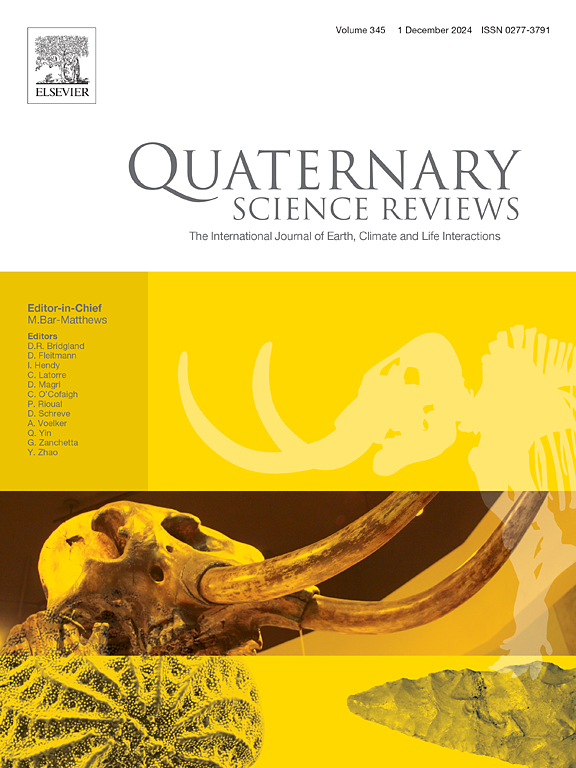小冰期以来北大西洋副热带高原对墨西哥中东部水文气候的调节作用
IF 3.3
1区 地球科学
Q1 GEOGRAPHY, PHYSICAL
引用次数: 0
摘要
我们根据从墨西哥东部卡米达斯洞穴采集的石笋(K-Inc)中提取的多种代用指标推断,重建了过去 700 个公元纪墨西哥中东部的水文气候。对墨西哥水文气候变异性的预测引起了人们对未来可能发生的严重干旱和与人为气候变化导致全球气温升高有关的季节性水平衡波动的担忧(Murray-Tortarolo,2021 年)。东部地区影响着墨西哥的粮食生产和供应。模拟过去的气候,并通过古气候记录进行验证,可为气候变化提供宝贵的视角,并增强我们对未来预测的理解。然而,古气候记录的缺乏阻碍了我们对墨西哥东部过去水文气候变迁及其气候机制的了解。我们的记录涵盖了小冰河时期(LIA)到历史时期(HI),这是了解地球气候史向后工业时代过渡期间气候影响的关键时期。LIA 期间北大西洋副热带高纬度(NASH)强度降低,使得从公元 1600 年到 LIA 结束期间出现了明显的类似 NAO 的负变率阶段。因此,大陆内部的偏向经向气流促进了水汽入侵,增加了墨西哥东部发生锋面雨的冷涌频率,损害了 K-Inc δ18O记录的量效应。然而,在西元 1910 年洞穴被人为打开之后,K-Inc 的 δ18O 记录开始呈现出 20 年的振荡周期。在这种情况下,K-Inc 的微量元素有助于阐明调查期间降水机制的气候条件。东赤道太平洋(EEP)地带性海面温度(SST)变化与 K-Inc 痕量元素(Sr/Ca 和 Ba/Ca)之间的直观吻合揭示了它们之间的关系。东赤道太平洋温暖的地带性 SST 似乎与 LIA 期间墨西哥东部冬夏季节长度的变化有关。与此相反,在高海拔地区,K-Inc 的痕量元素显示出与东欧太平洋暖区海温的反相响应,这表明卡米达斯洞穴附近的气候条件更加潮湿。这种构造使我们对高纬度冲击期间东欧太平洋海温带变率的影响产生了疑问,这种影响很可能被更相关的气候强迫所掩盖。我们的研究结果使我们能够通过解决记录中的主要气候驱动因素来绘制气候情景。本文章由计算机程序翻译,如有差异,请以英文原文为准。
Hydroclimate modulation of central-eastern Mexico by the North Atlantic subtropical high since the little ice age
We reconstructed the hydroclimate of central-eastern Mexico over the last 700 common era (CE) based on inferences from multi-proxies from a stalagmite (K-Inc) collected at Karmidas cave, eastern México. Projections on hydroclimate variability in Mexico raise concerns about possible future occurrences of severe droughts and seasonal water balance fluctuations related to increased global temperatures caused by anthropogenic climate change (Murray-Tortarolo, 2021). The eastern region influences the production and supply of food to Mexico. Simulations of past climates, validated by paleoclimate records, yield valuable perspectives on climate change and enhance our understanding of future projections. However, the paucity of paleoclimatic records hinders understanding past hydroclimatic variations and their climatic mechanisms in eastern Mexico. Our record covers the Little Ice Age (LIA) through the Historical Interval (HI), a crucial period for understanding the climate repercussions spanning the transition from Earth's climatic history to the post-industrial era. The reduced intensity of the North Atlantic Subtropical High (NASH) during the LIA enabled a prominent negative phase of NAO-like variability from 1600 CE until the end of LIA. Consequently, preferent meridional airflow within the continent fosters the encounter of moisture-laden intrusions with the increased frequency of cold surges as the occurrence of frontal rain in eastern Mexico, impairing the amount effect on the K-Inc δ18O record. However, after the artificial opening of the cave in 1910 CE, the δ18O records of K-Inc began to exhibit a ∼20-year oscillatory periodicity. In this context, the trace elements of K-Inc help elucidate the climatic conditions that governed the precipitation regime during the investigated period. The visual alignment between the zonal sea surface temperature (SST) variability in the eastern equatorial Pacific (EEP) and the trace elements (Sr/Ca and Ba/Ca) of K-Inc reveals their relationship. Warm zonal SST in the EEP appears to be associated with changes in the length of the winter and summer seasons in eastern Mexico during the LIA. In contrast, over the HI, the trace elements of K-Inc show an anti-phase response to Warm zonal SST in the EEP, denoting wetter climate conditions at the vicinities of Karmidas Cave. This configuration led to questioning the influence of SST zonal variability in the EEP during the HI, which was probably masked by more relevant climate forcing. Our findings enabled us to draw climate scenarios by addressing the main climate drivers in our records.
求助全文
通过发布文献求助,成功后即可免费获取论文全文。
去求助
来源期刊

Quaternary Science Reviews
地学-地球科学综合
CiteScore
7.50
自引率
15.00%
发文量
388
审稿时长
3 months
期刊介绍:
Quaternary Science Reviews caters for all aspects of Quaternary science, and includes, for example, geology, geomorphology, geography, archaeology, soil science, palaeobotany, palaeontology, palaeoclimatology and the full range of applicable dating methods. The dividing line between what constitutes the review paper and one which contains new original data is not easy to establish, so QSR also publishes papers with new data especially if these perform a review function. All the Quaternary sciences are changing rapidly and subject to re-evaluation as the pace of discovery quickens; thus the diverse but comprehensive role of Quaternary Science Reviews keeps readers abreast of the wider issues relating to new developments in the field.
 求助内容:
求助内容: 应助结果提醒方式:
应助结果提醒方式:


